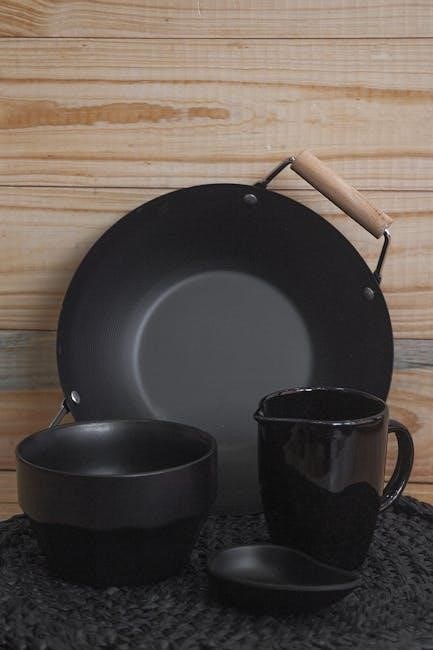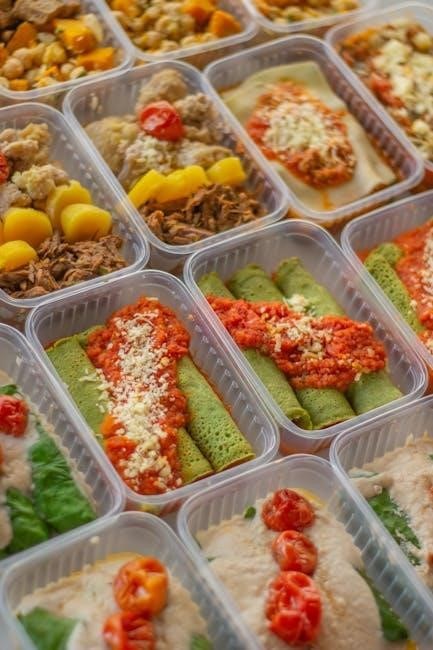90-30-50 method meal plan pdf free download
The 90-30-50 method meal plan focuses on daily intake of 90g protein‚ 30g fiber‚ and 50g healthy fats‚ promoting weight loss and metabolic health through balanced nutrition.
Overview of the 90-30-50 Diet Trend
The 90-30-50 diet trend has gained significant popularity‚ particularly on social media platforms like TikTok‚ as a structured approach to nutrition. It emphasizes hitting daily targets of 90 grams of protein‚ 30 grams of fiber‚ and 50 grams of healthy fats. This method is praised for its flexibility and balance‚ appealing to those seeking a clear framework without strict calorie counting. Proponents argue it supports blood-sugar balance‚ hormone regulation‚ and reduced inflammation. The trend is often described as a modern‚ accessible way to improve metabolic health and promote weight loss. Its rise in popularity is attributed to its simplicity and the backing of dietitians and influencers‚ making it a preferred choice for many looking to adopt a healthier lifestyle.
Importance of Macronutrient Balance in Weight Loss
Macronutrient balance is crucial for effective weight loss and overall health. Protein‚ fiber‚ and healthy fats play distinct roles. Protein preserves muscle mass‚ boosting metabolism‚ while fiber aids digestion and satiety. Healthy fats support hormone function and provide sustained energy. Balancing these nutrients ensures a structured approach‚ preventing nutrient deficiencies and promoting sustainable weight loss. The 90-30-50 method exemplifies this balance‚ offering a clear framework for optimal health.

The Science Behind the 90-30-50 Method
The 90-30-50 method leverages specific daily targets of protein‚ fiber‚ and healthy fats to optimize metabolism‚ support energy balance‚ and enhance overall nutritional efficiency effectively.
Role of Protein in the Diet (90g Daily Goal)
Protein plays a central role in the 90-30-50 method‚ aiming for 90g daily to support muscle maintenance‚ satiety‚ and metabolic health. It helps preserve lean muscle mass‚ essential for a healthy metabolism‚ while also promoting feelings of fullness‚ reducing cravings‚ and supporting weight loss. High-quality protein sources like lean meats‚ fish‚ and legumes are emphasized to maximize these benefits. Additionally‚ protein requires more energy to digest‚ boosting thermogenesis and fat burning. This focus on protein also aligns with blood-sugar balance‚ as it slows carbohydrate absorption‚ preventing spikes in insulin levels. Meeting the 90g goal ensures adequate nutrition while keeping the diet structured and easy to follow‚ making it a cornerstone of the 90-30-50 approach for sustainable weight management and overall well-being.
Significance of Fiber Intake (30g Daily Goal)
Fiber intake is crucial in the 90-30-50 method‚ with a daily goal of 30g to support digestive health‚ satiety‚ and blood-sugar balance. Fiber helps regulate bowel movements‚ preventing constipation and promoting a healthy gut microbiome. It also enhances feelings of fullness‚ reducing overall calorie intake and aiding in weight loss. By slowing carbohydrate absorption‚ fiber stabilizes blood sugar levels‚ preventing spikes and crashes. Additionally‚ a high-fiber diet is associated with improved cholesterol levels and reduced inflammation. Meeting the 30g fiber target encourages the inclusion of nutrient-dense foods like fruits‚ vegetables‚ and legumes‚ which are rich in vitamins‚ minerals‚ and antioxidants. This focus on fiber ensures a balanced and sustainable approach to nutrition‚ aligning with the method’s emphasis on long-term metabolic and overall health benefits.
Healthy Fats and Their Benefits (50g Daily Goal)
Healthy fats are a cornerstone of the 90-30-50 method‚ with a daily target of 50g to support energy‚ hormone production‚ and nutrient absorption. These fats‚ sourced from avocados‚ nuts‚ and olive oil‚ provide sustained energy and enhance the absorption of fat-soluble vitamins like A‚ D‚ E‚ and K. They also play a key role in hormone regulation‚ which is vital for metabolic function and overall health. Incorporating healthy fats helps maintain satiety‚ reducing cravings and supporting weight management. Unlike unhealthy fats‚ these options promote heart health by improving cholesterol levels and reducing inflammation. Meeting the 50g goal ensures a balanced diet that supports both physical and mental well-being‚ aligning with the method’s focus on sustainable and holistic nutrition.

Benefits of the 90-30-50 Meal Plan
The 90-30-50 meal plan improves metabolic health‚ supports weight loss‚ and enhances energy levels by balancing protein‚ fiber‚ and healthy fats‚ promoting overall well-being.

Weight Loss and Improved Metabolic Health
The 90-30-50 method supports weight loss by balancing protein‚ fiber‚ and healthy fats‚ which helps maintain muscle mass and reduce hunger. This approach improves insulin sensitivity‚ boosting metabolism and fat burning. By focusing on nutrient-dense foods‚ it promotes sustainable weight loss without extreme calorie restriction. The plan’s emphasis on protein preserves lean muscle‚ while fiber aids digestion and satiety. Healthy fats provide energy and support hormone function‚ further enhancing metabolic health. This balanced intake leads to better blood-sugar control and reduced inflammation‚ making it easier to achieve and maintain weight loss goals. The 90-30-50 method is designed to create a sustainable‚ long-term approach to weight management and overall metabolic well-being.
Blood-Sugar Balance and Hormone Regulation
The 90-30-50 method aids in stabilizing blood-sugar levels by balancing protein‚ fiber‚ and healthy fats‚ which slows carbohydrate digestion and prevents spikes in blood glucose. This balance supports insulin sensitivity‚ reducing the risk of type 2 diabetes and metabolic syndrome. The high protein intake helps regulate hormones like insulin and glucagon‚ while fiber promotes a steady release of glucose. Healthy fats‚ particularly omega-3s‚ reduce inflammation and support hormone production. By maintaining stable blood sugar and hormonal equilibrium‚ the plan enhances energy levels and overall endocrine function. This approach is particularly beneficial for those with blood-sugar concerns‚ offering a structured way to manage glucose and hormone health effectively.
Reduced Inflammation and Enhanced Energy Levels
The 90-30-50 method helps reduce inflammation by emphasizing healthy fats‚ particularly omega-3s‚ which are known for their anti-inflammatory properties. This‚ combined with a high intake of fiber and lean proteins‚ supports overall bodily health. By balancing macronutrients‚ the plan stabilizes energy levels‚ preventing sudden crashes and maintaining stamina throughout the day. The focus on whole‚ nutrient-dense foods minimizes the intake of pro-inflammatory substances like refined sugars and processed fats. This approach not only reduces inflammation but also enhances metabolic efficiency‚ leading to sustained energy and improved physical performance. The combination of protein‚ fiber‚ and healthy fats creates a synergistic effect‚ promoting long-lasting vitality and reducing chronic inflammation linked to various health conditions. This makes the 90-30-50 plan an effective strategy for those seeking optimal energy and reduced inflammation.

How to Follow the 90-30-50 Diet Plan
Start by setting daily goals: 90g protein‚ 30g fiber‚ and 50g healthy fats. Track intake using apps or meal planners to ensure targets are met consistently.

Setting Daily Nutrient Targets
Setting daily nutrient targets is the foundation of the 90-30-50 method. Aim for 90g of protein‚ 30g of fiber‚ and 50g of healthy fats each day. These targets are designed to support weight loss‚ improve metabolic health‚ and maintain energy levels. Protein helps build and repair muscle‚ while fiber aids digestion and keeps you full. Healthy fats support hormone production and overall well-being. By focusing on these specific goals‚ you can create a balanced and sustainable eating plan. Tracking these nutrients ensures you meet your dietary needs without overcomplicating calorie counting. This structured approach makes it easier to stay on track and achieve long-term success.
Tracking Macronutrient Intake
Tracking macronutrient intake is essential for success on the 90-30-50 method. Use a food diary or an app like MyFitnessPal to monitor daily protein‚ fiber‚ and fat consumption. Aim for 90g of protein from sources like chicken‚ fish‚ and legumes‚ 30g of fiber from vegetables‚ whole grains‚ and legumes‚ and 50g of healthy fats from nuts‚ avocados‚ and olive oil. Regular tracking helps ensure you meet these targets without overeating or undereating. It also promotes accountability and consistency‚ key factors for sustainable weight loss and improved metabolic health. By focusing on these macronutrient goals‚ you can create a balanced diet that aligns with your health objectives while allowing flexibility in food choices.
Incorporating Flexibility in Meal Choices
The 90-30-50 method emphasizes flexibility‚ allowing individuals to tailor meals to their preferences while meeting macronutrient goals. By focusing on daily targets rather than restrictive meal plans‚ this approach encourages creativity and adaptability. For example‚ you can swap chicken for turkey or salmon to meet the 90g protein goal. Vegetables‚ legumes‚ and whole grains offer varied options for achieving 30g of fiber. Healthy fats like nuts‚ avocados‚ and olive oil provide flexibility in adding flavor and texture to dishes. This adaptability makes the diet sustainable and enjoyable‚ ensuring long-term adherence without feeling deprived. It also accommodates different lifestyles and dietary preferences‚ making it accessible to a wide range of individuals seeking balanced nutrition and weight loss.

Meal Planning Strategies for Success
Plan meals that align with your 90-30-50 goals‚ ensuring balanced nutrition while allowing flexibility to suit your lifestyle and preferences for sustainable weight loss and health.
High-Protein Food Options (90g Protein Goal)
Achieving the 90g protein goal requires incorporating high-quality protein sources into meals. Lean meats like chicken breast and turkey are excellent choices‚ providing approximately 30-40g of protein per serving. Fatty fish such as salmon and tuna also contribute significantly‚ offering both protein and healthy fats. Eggs‚ Greek yogurt‚ and cottage cheese are versatile dairy options that add protein to breakfast and snacks. Vegetarian and vegan options include legumes like lentils‚ chickpeas‚ and black beans‚ as well as plant-based proteins like tofu and tempeh. Nuts and seeds‚ such as almonds and chia seeds‚ can also be used to boost protein intake. Balancing these options ensures a diverse and nutrient-rich diet‚ making it easier to meet the daily protein target.
High-Fiber Foods to Include (30g Fiber Goal)
Incorporating high-fiber foods is essential to meet the 30g daily fiber goal. Leafy greens like spinach‚ kale‚ and broccoli are rich in fiber and nutrients. Legumes such as lentils‚ chickpeas‚ and black beans are excellent sources‚ providing both fiber and protein. Whole grains like quinoa‚ brown rice‚ and oats also contribute significantly to fiber intake. Fruits such as berries‚ apples‚ and pears are delicious and fiber-rich options. Additionally‚ nuts and seeds like almonds‚ chia seeds‚ and flaxseeds can be added to meals for an extra fiber boost. Including a variety of these foods ensures a balanced diet and helps achieve the daily fiber target‚ supporting digestion and overall health.
Healthy Fat Sources (50g Daily Goal)
Healthy fats are crucial for meeting the 50g daily goal in the 90-30-50 method. Nuts like almonds‚ walnuts‚ and pecans are rich in healthy fats and can be easily incorporated into meals or snacks. Avocados are another excellent source‚ providing monounsaturated fats that support heart health. Fatty fish such as salmon and mackerel are not only high in fats but also packed with omega-3 fatty acids. Olive oil and coconut oil are great for cooking and adding to dishes. Seeds like chia‚ flax‚ and hemp also contribute to your daily fat intake. Including these sources ensures you meet your fat goals while maintaining a balanced and nutritious diet.

Sample Meal Plan Ideas
Discover delicious and balanced meal ideas that align with the 90-30-50 method. Breakfast options like scrambled eggs with spinach and avocado kickstart your day with protein and healthy fats. Lunches featuring grilled chicken‚ quinoa‚ and mixed veggies ensure fiber and nutrient balance. Dinners such as baked salmon with sweet potato and broccoli provide a perfect mix of protein‚ fiber‚ and fats. Snacks like Greek yogurt with berries or nuts keep you on track throughout the day‚ ensuring you meet your daily goals with ease and variety.
Breakfast Recipes for the 90-30-50 Diet
Start your day with nutrient-packed breakfast recipes tailored to the 90-30-50 method. Scrambled eggs with spinach and avocado provide a protein and healthy fat boost. Greek yogurt with chia seeds and berries offers a fiber-rich start. Protein smoothies made with whey protein‚ almond milk‚ and frozen spinach are quick and balanced. Whole-grain toast topped with almond butter and a sliced egg combines healthy fats and protein. Oatmeal with nuts and seeds is another fiber-packed option. These recipes ensure you meet your daily macronutrient goals while keeping meals flavorful and satisfying. Incorporate these ideas into your meal plan for a strong foundation toward your weight loss and health objectives.
Lunch and Dinner Ideas
For lunch and dinner‚ focus on balanced meals that align with the 90-30-50 goals. Grilled chicken or fish paired with fiber-rich vegetables like broccoli‚ Brussels sprouts‚ or asparagus make ideal protein-packed options. Salads with leafy greens‚ avocado‚ and a protein source like turkey or tofu are both nutritious and filling. Stir-fries with lean meats‚ mixed vegetables‚ and a drizzle of olive oil provide a healthy fat boost. Quinoa or brown rice bowls with roasted vegetables and a protein topping are also great choices. Incorporate legumes like lentils or chickpeas for added fiber and protein. These meals not only satisfy your macronutrient targets but also offer variety and flavor to keep your diet engaging and sustainable.
Snacks to Support Nutrient Goals
Snacks play a crucial role in maintaining macronutrient balance throughout the day. Opt for nuts or seeds like almonds‚ walnuts‚ or chia seeds‚ which are rich in healthy fats and fiber. Veggies like cucumbers‚ carrots‚ or bell peppers paired with hummus provide a fiber and protein boost. Hard-boiled eggs or a small portion of Greek yogurt are excellent protein-rich options. Cottage cheese with berries combines protein and fiber‚ while avocado slices offer healthy fats. These snacks not only help meet the 90-30-50 targets but also keep energy levels steady and support overall nutrition. Incorporating variety ensures you stay satisfied and motivated to stick to your meal plan.

Downloads and Resources
Download free PDFs for the 90-30-50 meal plan‚ including templates and trackers. Find reliable resources online to guide your nutrition journey effectively and effortlessly.
Free PDF Downloads for the 90-30-50 Meal Plan
Access free PDF guides for the 90-30-50 meal plan‚ offering structured templates‚ recipes‚ and tracking tools to help you achieve your daily nutrient goals effortlessly. These resources provide a comprehensive framework‚ including meal ideas and macronutrient breakdowns‚ to keep you organized and motivated. Download these printable plans to plan your meals in advance‚ ensuring you meet the 90g protein‚ 30g fiber‚ and 50g healthy fats targets. With these PDFs‚ you can track your progress‚ stay consistent‚ and enjoy a variety of delicious and nutritious meals. Simplify your nutrition journey with these convenient and accessible resources.
Where to Find Reliable Meal Plan Templates
Reliable 90-30-50 meal plan templates are widely available online‚ offering structured frameworks for tracking your daily protein‚ fiber‚ and healthy fat goals. Popular platforms like Pinterest and TikTok feature countless free resources created by registered dietitians and nutrition influencers. Additionally‚ health-focused websites and blogs provide downloadable PDF templates designed to simplify meal planning. These templates often include space for noting recipes‚ grocery lists‚ and daily progress. Many creators share these resources for free‚ making it easy to find one that suits your preferences. By leveraging these tools‚ you can stay organized and committed to your nutrition goals without the hassle of starting from scratch.
Tools for Tracking Macronutrient Intake
Tracking macronutrient intake is essential for adhering to the 90-30-50 method. Popular apps like MyFitnessPal and MyNetDiary allow users to log meals and monitor protein‚ fiber‚ and fat intake. Websites and spreadsheets are also widely used for manual tracking. Additionally‚ downloadable PDF templates provide a structured format for recording daily intake‚ making it easier to stay on track. Many templates are specifically designed for the 90-30-50 method‚ offering columns for each macronutrient and meal planning sections. These tools help users stay organized and ensure they meet their daily goals of 90g protein‚ 30g fiber‚ and 50g healthy fats. By leveraging these resources‚ individuals can maintain consistency and achieve better outcomes in their weight loss and metabolic health journey.

Tips for Sticking to the Plan
Sticking to the 90-30-50 plan requires meal prepping‚ setting realistic goals‚ staying hydrated‚ and tracking progress daily for consistent results.
Meal Prepping and Organization
Meal prepping is a cornerstone of the 90-30-50 method‚ helping you stay organized and consistent. Plan your meals weekly‚ portion out ingredients‚ and prepare dishes in advance to save time and reduce decision fatigue. Use storage containers to keep meals fresh and accessible. Prepping also ensures you meet your daily macronutrient goals without hassle. Dedicate one day a week to shop for groceries and prepare meals‚ making healthy choices easier. This strategy not only saves time but also helps avoid last-minute‚ less nutritious options. By organizing your meals‚ you can maintain variety and excitement‚ keeping your diet enjoyable while staying on track with your 90-30-50 goals.
Avoiding Common Pitfalls
Avoiding common pitfalls on the 90-30-50 method requires careful planning and mindfulness. Overconsumption of healthy fats or underestimating protein portions can derail progress. Many individuals overlook fiber intake‚ leading to nutrient imbalances. Neglecting meal variety can result in boredom or cravings‚ potentially causing deviations. Additionally‚ relying too heavily on processed foods‚ even if they fit macronutrient goals‚ can hinder long-term success. It’s also important to avoid unrealistic expectations and extreme restriction‚ as this may lead to burnout. Stay flexible‚ listen to your body‚ and adjust portions as needed. Regularly tracking intake and staying educated on nutrient-dense foods helps maintain consistency and prevents common mistakes. By staying mindful of these potential pitfalls‚ you can sustain a balanced and enjoyable approach to the 90-30-50 method.
Maintaining Motivation and Consistency
Maintaining motivation and consistency on the 90-30-50 method meal plan is crucial for long-term success. Start by setting realistic goals and celebrating small achievements‚ which helps build confidence and momentum. Surrounding yourself with a supportive community‚ such as online forums or social media groups‚ can provide encouragement and practical tips. Tracking progress through journals or apps keeps you accountable and motivated. Incorporating variety in meals ensures the diet remains enjoyable and prevents monotony. Additionally‚ focusing on how the plan improves overall health‚ rather than just weight loss‚ can sustain your commitment. Staying educated about the benefits of the 90-30-50 method reinforces its value‚ helping you stay dedicated to your health journey.
The 90-30-50 method meal plan offers a structured approach to balanced nutrition‚ supporting weight loss and metabolic health through targeted macronutrient goals‚ with resources like free PDFs available online to guide your journey sustainably.
Final Thoughts on the 90-30-50 Method
The 90-30-50 method stands out as a balanced and flexible approach to nutrition‚ emphasizing protein‚ fiber‚ and healthy fats. By setting clear daily goals‚ it simplifies the process of achieving metabolic health and weight loss. The plan’s focus on whole foods and macronutrient tracking makes it appealing for those seeking structure without restrictive dieting. With resources like free PDF downloads‚ individuals can easily adopt and maintain this method long-term. Its popularity on platforms like TikTok highlights its effectiveness and accessibility‚ making it a viable option for anyone looking to improve their dietary habits and overall well-being.
Encouragement for Long-Term Success
Embracing the 90-30-50 method requires commitment‚ but its benefits‚ like improved health and sustained weight loss‚ make the journey worthwhile. Consistency is key to seeing results and maintaining motivation. Utilize tools like free PDF meal plans to stay organized and inspired. Celebrate small victories along the way‚ as every step forward contributes to long-term success. Remember‚ this plan is not just a diet but a lifestyle change focused on nourishing your body with balanced nutrients. By staying dedicated and flexible‚ you can achieve your health goals and enjoy a more vibrant‚ energetic life. Keep pushing forward—you’ve got this!

